 |
 |
|
|
 |
 |
|
|
|
50th Wedding Anniversary
Portrait, 1979 |
They Were A Stylish, Handsome Couple |
|
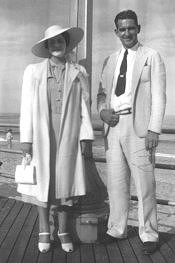
Boardwalk,
Atlantic City, 1930 |
|
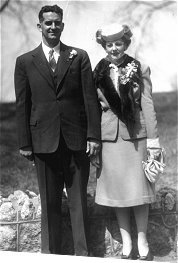
After Church, 1945 |
|
|
|
|
|
Robert Francis Edwards
 Born of working-class Welsh and English parents in Philadelphia in 1908, Robert Francis Edwards developed into a
successful middle-class businessman with a reputation as a warm, giving humanitarian who cared about his friends, his family and his community. Born of working-class Welsh and English parents in Philadelphia in 1908, Robert Francis Edwards developed into a
successful middle-class businessman with a reputation as a warm, giving humanitarian who cared about his friends, his family and his community.
College?
In the late 1920s, his parents, unable to afford college, sent him and his brother Benjamin Lewis "Mick" Edwards,
to laundry school in Cincinnati, Ohio. That's where "Bud" met Lillian
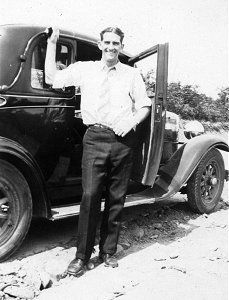 Hi Neighbor! Hi Neighbor!
One afternoon, while looking out the window of their house on Morris Avenue Lillian's sister, Marcie Kerr, spotted the
handsome "Bud", and called her sister to see the handsome new boy next door.
Every guy remembers his first set of wheels.
Lillian made her move and she and Bud eventually fell in love.
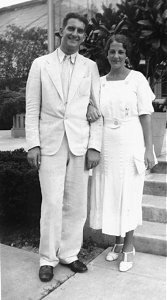
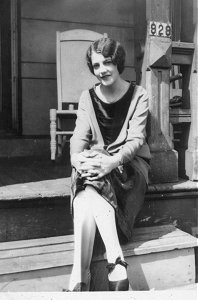
Waiting on the front porch
for her beau.
Wherever they went, they were looked upon as a stylish couple. They just looked right together. And in spite of difficult times, their individual warmth - expressed
outwardly in easy smiles - was infectious. They were a much admired couple.
The dapper gentleman had good threads,
a banded hat and shined shoes. |
|
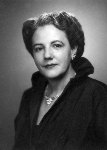 Lillian Marie Kerr Edwards Lillian Marie Kerr Edwards
Born in Cincinnati in 1908, Lillian Marie Kerr was the youngest of four children. As a child, she learned little of the music that so inspired her father. She was by all
accounts an average child, except for a strong independent streak.
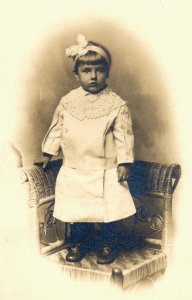 Her family was poor, but always managed to prosper in spirit. Lillian did well in school and went on to study business at the
Littleford Business College. Later she secured a position in the main office of Procter and Gamble in Cincinnati. In order to have money to get married, she
sold her stock in the company. Her family was poor, but always managed to prosper in spirit. Lillian did well in school and went on to study business at the
Littleford Business College. Later she secured a position in the main office of Procter and Gamble in Cincinnati. In order to have money to get married, she
sold her stock in the company. A remarkably well-preserved photo
from 1912.
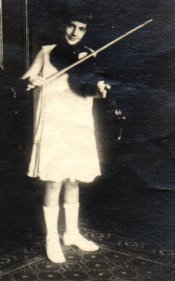 Her father was a maker of string instruments - 'cellos being his specialty. He traveled back to his native Germany, to the black forest
to chose specific trees for shipping back to the U.S., where he cured the wood in large vats. He also choose trees from the forests of Kentucky. Many members of
the Cincinnati Symphony used Kerr violins, violas and 'cellos. Lillian learned to play at an early age, but music was not her calling. She was just not a musician. Her father was a maker of string instruments - 'cellos being his specialty. He traveled back to his native Germany, to the black forest
to chose specific trees for shipping back to the U.S., where he cured the wood in large vats. He also choose trees from the forests of Kentucky. Many members of
the Cincinnati Symphony used Kerr violins, violas and 'cellos. Lillian learned to play at an early age, but music was not her calling. She was just not a musician.
Lil with a 20s "flapper" look.
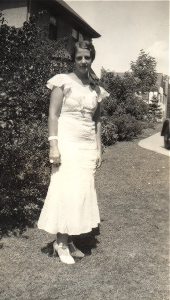
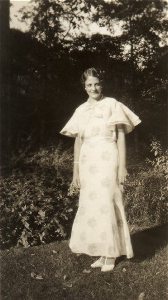
Even print dresses were stylish back then |
|
|
Looks were important; dressing up in spite of one's circumstances was typical of the mindset left over from
the Victorian Age. Even though it was the heart of the Depression Era, Lillian and Bud presented a stylish image.
A successful business image was important and useful. |
|
 |
|
|
|
A Move For Business
For a brief time, they lived in East Orange, New Jersey.
A single room was a humble home, but at least it had a radio!But Bud wanted
his own business; he didn’t like working for someone else. So they decided to move to Pennsylvania where the rest of his family was located so they
could establish their own laundry.
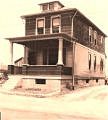 Wilkes-Barre, Pennsylvania is the heart of the Wyoming Valley - after
which the state of Wyoming is named. Known locally as "The Valley," it was a melting pot of Eastern European laborers, mostly coal miners
and craftsman. They moved in with Bud's brother Mick, sister Winona and father Lionel, a chemical salesman. The two brothers established
an industrial laundry, "Edwards Overall Laundry" serving heavy industry, prisons and hospitals. Wilkes-Barre, Pennsylvania is the heart of the Wyoming Valley - after
which the state of Wyoming is named. Known locally as "The Valley," it was a melting pot of Eastern European laborers, mostly coal miners
and craftsman. They moved in with Bud's brother Mick, sister Winona and father Lionel, a chemical salesman. The two brothers established
an industrial laundry, "Edwards Overall Laundry" serving heavy industry, prisons and hospitals.
The First Laundry. . .
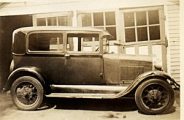 They bought equipment and installed it in a garage behind
Lionel’s house in a section of town that didn't yet have paved streets. All the dirt became a problem trying to keep cleaned clothes clean. Deliveries were made in the family car. They bought equipment and installed it in a garage behind
Lionel’s house in a section of town that didn't yet have paved streets. All the dirt became a problem trying to keep cleaned clothes clean. Deliveries were made in the family car.
|
|
|
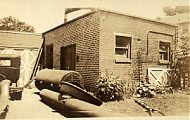 And The Second laundry. . .
And The Second laundry. . .
A few years later, they moved into a small rented building a few blocks away, behind a neighbor's house.
And The Third...
Later, they purchased a building from a failed dairy down the street (pictures of that
building were destroyed in the flood of 1972) and added a long side room to hold additional equipment in their expanding business. It was the final location for a successful business
that had grown rapidly, but which was about to fall victim to progress. |
|
 |
|
|
|
Young Boy's Fantasy Playground
The laundry was a fantastic sight to all the neighborhood boys: 6-ft. tall steam engines with fast spinning
gyroscopes on top. (Picture that!) The steam engines had large bicycle-type wheels with wide leather belts attached that turned 80 ft.-long horizontal iron rods which had more leather belts
hanging from them which then turned huge horizontal washing machines. The washers rotated along a vertical axis like concrete mixers and were so big 3 adults could fit inside. Mr. Edwards
tell the story of the “the clothes dryers that were big enough to fit two of us boys inside, and sometimes on Saturday afternoons we would sneak inside to play in our ‘fort’." To break
him of the habit of playing inside the dryers, his father closed the door on him one afternoon and started the dryer going. After the initial fright, thinking it was cool pretending to be a
gerbil spinning its wheel - until the heat started to flow and then the panic set in. His father let him out and he never went inside again. |
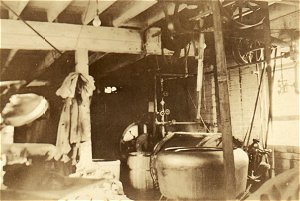
The first laundry - In the foreground is the powerful Extractor run by leather belts from the bicycle wheels
above. On the left is a large press with its lid up. |
Freemasonry and Shriners
 Freemasonry is a fraternal organization with
moral and metaphysical ideals which include a constitutional declaration of belief in a Supreme Being. Bud was a 33rd degree Mason, a member of King Hiram Lodge and a Shriner. It
was an important part of his life and he participated in ceremonies and education for as long as he was able. Freemasonry is a fraternal organization with
moral and metaphysical ideals which include a constitutional declaration of belief in a Supreme Being. Bud was a 33rd degree Mason, a member of King Hiram Lodge and a Shriner. It
was an important part of his life and he participated in ceremonies and education for as long as he was able.
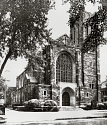
In addition to his community service through the Freemasons, Bud served for many years as a Deacon, and as Chairman of the Board of Deacons, of
the First Baptist Church of Wilkes-Barre.
|
|
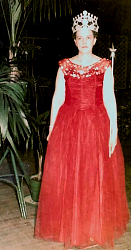 The Order Of Eastern Star The Order Of Eastern Star
The OES (an adoptive rite of Freemasonry with teachings based on the Bible and objectives that are charitable and benevolent) was as
important a part of Lillian's life as Freemasonry was in her husband's life. She was a Past Matron and a 50-yr. member of the Irem Women's Auxiliary where she served as
Parliamentarian.
This photo was taken in 1954 at a Grand Chapter gathering in Philadelphia.
|
|
|
 |
 |
 |
 |
 |
 |
 |
 |
 |
 |
 |
|
 |
 |
 |
 |
 |
 |
 |
 |
 |
 |
 |
 |
 |
 |
 |
 |
 |
|
Robert Lewis Edwards
Born November 23, 1946, the only child. Spoiled, encouraged, supported - allowed to develop an independent personality, but always with strong guidance.
|
|
|
|
Every guy
remembers his
first set of wheels! |
|
|
|
|
It was a loving and caring home life, with lots of attention; an only child rarely is left without it. Neighborhood children replaced
"missing" brothers and sisters. But an only child is often a "lonely" child, and that was the case with Robert. As a 7-yr. old, he just couldn't understand why his 45 year-old
parents wouldn't have any more children. |
|
|
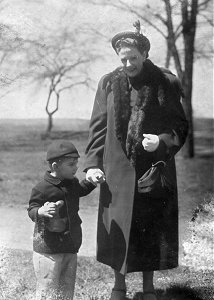 |
|
|
|
|
|
|
|
|
|
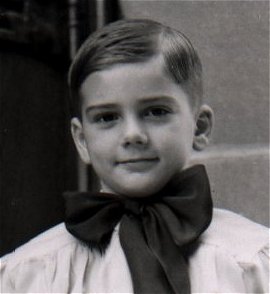 |
|
|
|
It is amazing how many musicians got their start in the church choir. Lillian often told the story of how baby Robert would cry
and fuss in church, until the church organ started to play and then the crying stopped. A born musician responding at an early age to the sounds that would shape the first half of his life. There was
an early affinity toward music - as a little baby who stopped crying when the church organ started to play (and started crying again when it stopped!) to a natural draw to the keyboard. |
|
|
|
After Church ca. 1949 |
|
|
|
|
|
|
|
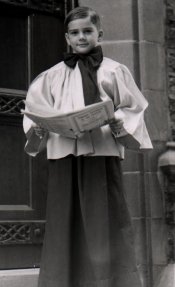 |
|
|
|
|
|
|
|
|
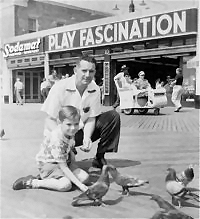 |
|
|
|
|
|
|
|
|
Just look at that face! Its the exact same expression you see on the "Musician" page in the "Conductor" photo taken 30 years later. Here at 8, possibly the
last year of innocence, the eyes showed an active, aware mind. And the wry smile hinted at the wit to come. |
|
|
|
|
|
|
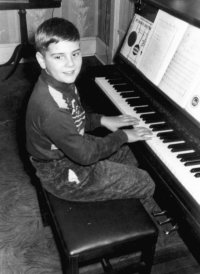 |
|
|
|
|
|
|
Every Labor Day, the family visited Atlantic City. Back then, pigeons were friends, not carriers of disease. That Sodamat in the
background was Robert’s most favorite place to visit. Embedded in a black marble wall, tall, silver bullet-like Deco columns dispensed an unimaginable variety of sodas. “I wanted to get
sick on all the flavors.” |
|
|
|
|
|
|
(This is one of a series of photos taken by Robert Francis Edwards with his hooded studio camera which was rarely moved
outdoors. To see a full-size version of this photo, and more of the artistic photography of Robert Francis Edwards, visit the slideshow page.) |
|
|
|
|
|
|
|
|
|
Because he had no siblings, Robert developed strong friendships with his “gang” in which he, of course, had made himself the
leader. Demanding a leadership position at such an early age was partially the independence of an only child, and partially the developing performer personality with which he was born. |
|
|
|
|
|
|
The piano was a Gulbransen upright with copper bass strings, purchased from Hildebrand’s music store on W. Market
Street. The young man’s posture improved. |
|
|
|
|
Public school was the wrong place for this boy - he suffered every year of it, longing to go to the private school his parents
couldn't afford.
His high school guidance counselor saw him once - in the spring of his senior year, and told him that because of his grades, he had no chance of going to college. Further, if he
happened to be admitted, he wouldn't last six weeks. Even though Robert was thoroughly intimidated by this aggressive counselor, he still managed to wonder just what manner of guidance counselor is
unable to tell when a student is under-performing because he is bored and not able to relate to the swine surrounding him? At the end of Robert’s first college semester, former guidance counselor Enzo
Frosinni received a copy of Robert’s grade report - all A's, along with a note thanking him for all the years of encouragement and support he had given. By this time, the Art of Sarcasm wasn't
even an effort for Robert.
The 1964 magna cum laude graduation from the fully accredited Westminster Choir College, Princeton, NJ was later followed by an intense 2-year Masters program at Temple
University, and the awarding
of a Master of Music degree, summa cum laude. |
|
|
|
|
|
|
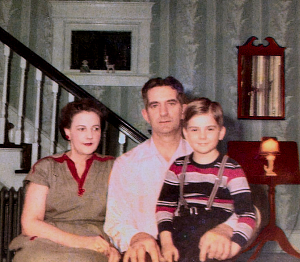 |
|
|
|
|
|
 |
 |
|
The 25th Wedding Anniversary
It was a big social event in 1955. Members of the business community, fraternal organizations, church groups,
relatives, friends and neighbors all
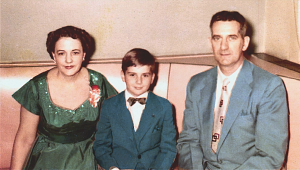 gathered in the ballroom of the grand Hotel Sterling
overlooking the scenic river park. gathered in the ballroom of the grand Hotel Sterling
overlooking the scenic river park. “I was 9 years old and this was the first social event I remember attending. I couldn't understand why everyone thought my parents
were so important; to me, they were just mom and dad.” . |
|
 |
 |
|
The Winds Of Change
The industrial laundry service business prospered until about 1955, when a new type of laundry became available - the storefront laundromat. No
expertise required - just lease machines, set them up and allow people to deposit their money. No liability, nor effort for the owners.
Then, as washers and dryers became standard in most
homes, and as prisons and hospitals cut costs by establishing their own in-house laundries, the industrial laundry service began to evaporate. Corporate consolidation occurred rapidly. In the 60s,
Coyne Laundries offered to buy the business from my father and uncle, promising my father a desk job. As soon as they signed all of my father's customers to long-term contracts, Coyne rewarded him with
a pink slip.
Life Goes On
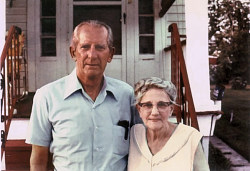 Even though he was approaching 60 years of age, his work ethic caused him to seek employment, and he found a job as an elevator operator in one of the last
department stores to have manually operated elevators. He loved it! And the customers loved the friendly, helpful, always smiling Bud. When the store finally
converted to automatic elevators, he found another job as a night watchman at a local grade school.
Even though he was approaching 60 years of age, his work ethic caused him to seek employment, and he found a job as an elevator operator in one of the last
department stores to have manually operated elevators. He loved it! And the customers loved the friendly, helpful, always smiling Bud. When the store finally
converted to automatic elevators, he found another job as a night watchman at a local grade school.
A Life Of Service
He continued his life of service as an active Mason and Shriner and as a Deacon of the First Baptist Church.
The End
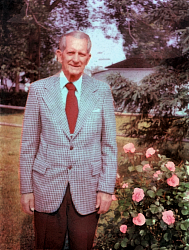 Sadly, his life did not end well. After his retirement, he spent a lot of time tending his garden - he not only grew the best-tasting tomatoes imaginable, but he was a master grower of
roses and he had an extensive variety of trees and flowers including a Japonica Quince tree, male and female holly trees (so there would be berries), and a beautiful bed of Lilies of the
Valley - which he grew to honor his "Lilly of the Valley."
Sadly, his life did not end well. After his retirement, he spent a lot of time tending his garden - he not only grew the best-tasting tomatoes imaginable, but he was a master grower of
roses and he had an extensive variety of trees and flowers including a Japonica Quince tree, male and female holly trees (so there would be berries), and a beautiful bed of Lilies of the
Valley - which he grew to honor his "Lilly of the Valley." Unfortunately, he began to be repeatedly harassed by a low-life, lunkheaded neighbor boy.
One day in early October 1980, when no one was home at the boy's house, that mouth-breathing lummox apparently decided to demonstrate his prowess by having two of his
wrestling buddies join him in verbally abusing and threatening physical violence on this gentle, defenseless 72 yr.-old man who suffered from diabetes and a congenital heart condition. “My
father managed to get as far as the back porch steps before collapsing. Later, he was able to get into the house, but his health spiraled downward and he died within a few weeks, just
before my parents 50th wedding anniversary. I don't know the current whereabouts of the muscle-brained ameba, but there is little doubt where he will spend eternity.” A Living Tribute
“In 1997, to honor my father's life, I decided to create a memorial that would be both permanent and useful: I commissioned
a setting of his favorite Welsh hymn, "Cym Rhonda" from Gil Martin, whom I considered to be the finest living composer of
sacred music in the world at that time. ” Sharing Personal space...
I’ve included a page of pictures of
one of my favorite apartments, if you care to visit. |
|
|

